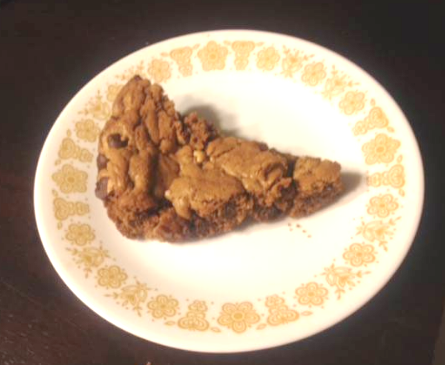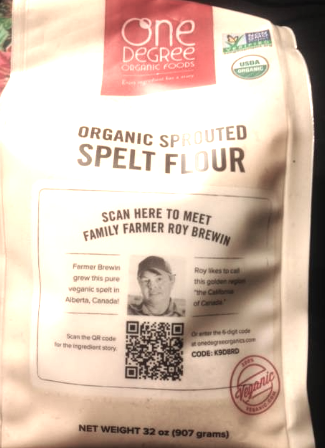
This chocolate chip cookie is made in an iron skillet and more resembles a chewy brownie than a cookie.
Is there a Healthy Chocolate Chip Cookie?
Maybe there are healthy chocolate chip cookies out there—at least healthier and easier to make than the traditional toll house variety. I tried this recipe yesterday from Donna Schwenk's "Cultured for Life" recipes. It's probably not going to win over any hard-core toll house fans as it is a tad on the unsweet side, but I like it and the second piece is better than the first.
Skillet Sprouted Chocolate-Chip Cookie
What to do on a rainy day? Try out new recipes. This one is made in a iron skillet—no bowl to clean up—just stir and bake. The following recipe makes one 8-inch cookie—8 to 10 servings. Slice the cookie like a pie.
Materials: 8 inch iron skillet
Ingredients:
1 stick (½ cup) unsalted butter
1 cup Coconut Sugar or Sucanat
1 teaspoon Vanilla Extract
1 large egg
1½ cups Sprouted White-Wheat Flour
½ teaspoon baking soda
¼ teaspoon Celtic Sea Salt
1 cup organic dark or semisweet chocolate chips
__________________________________________________________________________
Preheat the oven to 350°F.
Melt the butter in an 8-inch cast-iron skillet over medium-low heat.
Stir in the Sucanat (or organic sugar) and vanilla.
Remove the pan from the heat and let it stand until it is just warm, about 5 minutes.
Crack the egg onto the butter mixture, and use a fork to combine.
Add the flour, baking soda, and salt, and stir carefully until the mixture is smooth.
Add the chocolate chips and stir until evenly distributed throughout the dough.
Bake for 15 minutes, or until the cookie turns golden on top and around the edge, but remains soft in the center. Serve warm from the pan
______________________________________________________________________________

Note on my introduction to "One Degree Organic Foods"--the organic sprouted Spelt Flour I used to make these chocolate chip brownies.
One degree (of separation) farmers are proud to stand behind their harvests. That's why you'll see their photos right on their packaging. But that's just the first step. You can scan their QR code to make an extraordinary level of transparency come alive. Or you can go to onedegreeorganics.com and enter the six digit code K9D8RD. Very interesting.
____________________________________________________________
What to do with the rest of this cloudy Day? Make some ginger soda starter!
According to many sources, ginger is a great help in dealing with high blood sugars, muscle cramps, nausea, asthma and hay fever. Ginger is considered stronger than a non-steroidal anti-inflammatory drug (NSAID). In 2004 Biological and Pharmaceutical Bulletin reported that ginger can suppress cortisol production. High levels of cortisol can increase belly fat and contribute to weight gain. In 2014 the International Journal of Food Science and Nutrition reported that ginger taken daily for eight weeks reduced insulin sensitivity and fasting blood sugar levels in Type 2 diabetics.
GINGER STARTER RECIPE from Donna Schwenk
Materials: One pint Mason jar, cloth, strong rubber band
Ingredients: ginger root, organic sugar, water
____________________________________________________
2 tablespoons grated ginger root
2 tablespoons organic sugar
2 cups of water
PROCESS
1. Grate ginger
2. Add ginger sugar and water to pint mason jar
3. Feed once daily for 3 to 5 days: two tablespoons ginger and two tablespoons sugar (when bubbly, it's ready to use)
4. When not in use, store in refrigerator for up to one week (must be fed once a week)
5. When ready to use again, feed and wait 24 hours for bubbles to return.
6. After using your starter to make ginger soda, add a cup of water to your starter mix.
________________________________________________________________________
GINGER SODA
Ingredients: 1/4 cup Ginger Starter; 1/8 cup sugar; four cups of water
PROCESS
1. Boil water and stir in sugar until dissolved
2. Allow water to cool
3. In a 32 ounce bottle add sugar water and ginger starter.
4. Top off with extra water leaving one-inch space from top of bottle.
5. Cap it tightly. (Burp it every other day by loosening and then tightening the lid.)
6. Allow to ferment two to five days
7. Strain to remove ginger pieces
8. Pour into bottles and tightly cap
9. Store in refrigerator for up to a week.
Ingrediants: